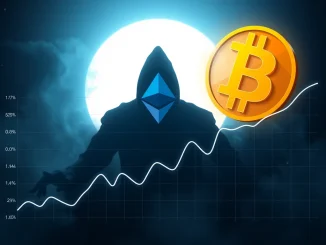
The cryptocurrency world is buzzing, and for good reason! Bitcoin has once again captured global attention, executing a monumental surge past the $118,000 mark in July 2025. This isn’t just another fleeting rally; it’s a profound shift, largely fueled by an unprecedented $14.8 billion in institutional inflows and the transformative impact of Spot Bitcoin ETFs. This confluence of factors is not only pushing the Bitcoin price to new heights but also signaling a pivotal moment in its journey towards widespread mainstream adoption.
The Avalanche of Institutional Inflows: Fueling Bitcoin’s Ascent
The narrative around Bitcoin has dramatically shifted from a niche, volatile asset to a legitimate and increasingly indispensable component of diversified investment portfolios. A staggering $14.8 billion in institutional inflows has poured into the digital asset space, serving as the primary catalyst for Bitcoin’s surge. These aren’t just speculative bets; they represent calculated moves by major financial players seeking exposure to a burgeoning asset class. This influx of capital, channeled through regulated investment vehicles, has significantly bolstered investor confidence, positioning Bitcoin firmly within the mainstream financial ecosystem. We’re seeing a clear endorsement from traditional finance, a testament to Bitcoin’s growing maturity and perceived stability.
This institutional embrace is a powerful signal to both retail and corporate investors alike, affirming Bitcoin’s long-term viability. For instance, consider strategic corporate actions like Volcon Inc.’s significant acquisition of 3,183 Bitcoin at an average price of $117,697. This move, despite Bitcoin’s record valuation at the time, underscores a growing trend of corporations making substantial bets on the asset, viewing it as a strategic treasury reserve. Such large-scale purchases contribute directly to the upward pressure on the Bitcoin price and reflect a deeper conviction in its future value.
Spot Bitcoin ETFs: Redefining Access and Driving Mainstream Adoption
Perhaps the most significant development in recent times has been the launch and subsequent success of Spot Bitcoin ETFs. These exchange-traded funds have fundamentally redefined how investors gain exposure to Bitcoin. No longer do you need to navigate complex crypto exchanges or worry about direct custody risks; these ETFs offer a streamlined, regulated, and familiar pathway for both institutional and retail investors. The numbers speak for themselves: daily net inflows into U.S. Spot Bitcoin ETFs reached an impressive $226.7 million in July alone, indicating a sustained and robust demand from institutional players. This consistent buying pressure is a critical factor in the ongoing Bitcoin surge.
Prominent figures in the financial world are also lending their weight to this new paradigm. Michael Saylor, a staunch Bitcoin advocate, famously describes Bitcoin as a “treasury reserve asset,” highlighting its potential as a long-term store of value for corporations. Similarly, Tom Lee, a respected market strategist, forecasts continued upward momentum, reinforcing the bullish sentiment surrounding these investment vehicles. The endorsement from such influential figures, combined with the ease of access provided by ETFs, is normalizing Bitcoin’s role in diversified portfolios and significantly accelerating its mainstream adoption.
Bitcoin Market Maturation: Beyond Speculation to Strategic Allocation
The current market cycle demonstrates a clear maturation of the Bitcoin ecosystem. We’re moving beyond the days when Bitcoin was primarily seen as a speculative play for retail traders. Today, the focus has shifted towards long-term institutional allocation, a trend underscored by Bitcoin’s realized capitalization surpassing $1 trillion for the first time. This metric, which measures the value of all bitcoins at the price they were last moved, indicates a significant amount of capital is being held by long-term investors, rather than being actively traded.
This shift signifies a growing confidence in Bitcoin as a durable asset, capable of holding its value over extended periods. It suggests that institutions are not just dabbling; they are strategically integrating Bitcoin into their balance sheets and investment strategies. This profound change in market dynamics contributes to a more stable and resilient Bitcoin price, fostering an environment where large-scale investments feel more secure. The transition from speculative trading to strategic, long-term holdings is a cornerstone of Bitcoin’s surge and its journey towards complete financial integration.
The Broader Crypto Market: Altcoins and Cross-Chain Interest
While Bitcoin’s surge dominates headlines, it’s important to look at the broader crypto market. Bitcoin’s unchallenged dominance continues to act as the primary driver for the entire digital asset space. However, other cryptocurrencies, particularly Layer 1 protocols, have also experienced varying degrees of performance. Ethereum, for instance, experienced mixed performance but still saw substantial ETF inflows, totaling $4.67 billion in July. This indicates a strong cross-chain interest and continued belief in the utility and growth of the Ethereum ecosystem, even if it trails Bitcoin in headline traction. Altcoins, generally, have seen increased volatility.
Dogecoin, a prominent meme coin, saw a surge amid renewed crypto-driven optimism, though it faces resistance near critical price levels. This highlights the inherent risk and speculative nature still present in many altcoin markets. The performance of these alternative assets often correlates with Bitcoin’s momentum, reinforcing Bitcoin’s role as the crypto market’s linchpin. A strong Bitcoin price often creates a positive ripple effect, drawing capital and attention to the wider digital asset landscape, though specific altcoin performance remains highly dependent on individual project developments and market sentiment.
Bitcoin Price Resilience: Defying Traditional Macroeconomic Benchmarks
One of the most remarkable aspects of the recent Bitcoin surge is its apparent decoupling from traditional macroeconomic benchmarks. Historically, cryptocurrencies have shown sensitivity to global economic indicators, particularly interest rate decisions from central banks like the Federal Reserve. However, Bitcoin’s price resilience above $118,000 has largely defied these conventional correlations. This can be attributed to the overwhelming demand generated by Spot Bitcoin ETFs and strategic corporate purchases. These new sources of demand have created a robust buying floor, effectively insulating Bitcoin from the usual fluctuations triggered by Federal Reserve rate decisions or other traditional market news.
This growing independence signifies a new phase for Bitcoin, where its valuation is increasingly driven by its unique supply-demand dynamics within the digital asset ecosystem, rather than solely by external economic pressures. This resilience further solidifies its appeal as a potential safe-haven asset for investors looking to diversify beyond traditional financial instruments, making the Bitcoin price less susceptible to conventional market volatility.
The Future Outlook for Bitcoin: Bullish Trajectories and Emerging Challenges
Looking ahead, analysts project a highly bullish trajectory for Bitcoin. Some forecasts are incredibly ambitious, suggesting peaks near $250,000 if the current trends of institutional adoption and ETF inflows persist. However, these optimistic projections are contingent on several critical factors: sustained regulatory clarity, continued innovation in financial products, and the ongoing maturation of the underlying blockchain technology. The ETF-driven surge has not only benefited Bitcoin directly but has also had a positive spillover effect on select Layer 1 protocols and other promising altcoins, reinforcing Bitcoin’s foundational role in the entire crypto market.
Importantly, this wave of institutional adoption appears to be recalibrating Bitcoin’s notorious volatility profile. As more large, long-term holders enter the market, the asset is becoming less prone to extreme price swings, fostering a more stable environment for both retail and institutional stakeholders. While challenges like regulatory uncertainties in various jurisdictions and potential market corrections remain, the current trajectory points towards a future where Bitcoin is an undeniable force in global finance.
Conclusion
The recent Bitcoin surge past $118,000 marks a truly transformative period for the cryptocurrency. Driven by an unparalleled wave of institutional inflows and the widespread embrace of Spot Bitcoin ETFs, Bitcoin is not just reaching new price milestones; it’s solidifying its position as a legitimate, accessible, and increasingly stable asset class. This era of profound mainstream adoption is reshaping the entire crypto market, demonstrating Bitcoin’s resilience and its growing independence from traditional economic forces. As institutional players continue to integrate Bitcoin into their strategies, and as innovative financial products simplify access, the future of Bitcoin appears brighter and more integrated into the global financial landscape than ever before. This isn’t just news; it’s a financial revolution unfolding before our eyes, promising exciting developments for investors and the broader digital economy.
Frequently Asked Questions (FAQs)
1. What caused Bitcoin’s recent surge past $118,000?
Bitcoin’s surge was primarily driven by two major factors: significant institutional inflows, exceeding $14.8 billion, and the increasing demand generated by the launch and success of Spot Bitcoin ETFs. These factors have bolstered investor confidence and provided easier, regulated access to the asset.
2. How do Spot Bitcoin ETFs contribute to mainstream adoption?
Spot Bitcoin ETFs allow investors to gain exposure to Bitcoin’s price movements without directly owning or securing the cryptocurrency. This simplifies the investment process, reduces custody risks, and makes Bitcoin accessible through traditional brokerage accounts, thereby accelerating its mainstream acceptance and institutional integration.
3. What is “institutional adoption” in the context of Bitcoin?
Institutional adoption refers to large financial institutions, corporations, and investment firms investing in or integrating Bitcoin into their portfolios and operations. This includes direct purchases (like Volcon Inc.), investments through ETFs, and treating Bitcoin as a treasury reserve asset, signaling long-term confidence in its value.
4. How has Bitcoin’s market dynamics changed?
The market has matured significantly, shifting from primarily speculative trading to long-term institutional allocation. This is evidenced by Bitcoin’s realized capitalization surpassing $1 trillion, indicating that more capital is being held by long-term investors, contributing to increased stability and legitimacy.
5. Are altcoins also benefiting from Bitcoin’s surge?
While Bitcoin remains the primary driver, its strong performance often creates a positive ripple effect across the broader crypto market. Ethereum has seen substantial ETF inflows, and some altcoins like Dogecoin have experienced surges, though their performance can be more volatile and dependent on individual project developments.
6. What is the future outlook for Bitcoin’s price?
Analysts project a bullish trajectory for Bitcoin, with some forecasts suggesting peaks near $250,000. These projections depend on sustained regulatory clarity, continued innovation in financial products, and ongoing institutional adoption, which is also contributing to a more stable volatility profile for Bitcoin.



